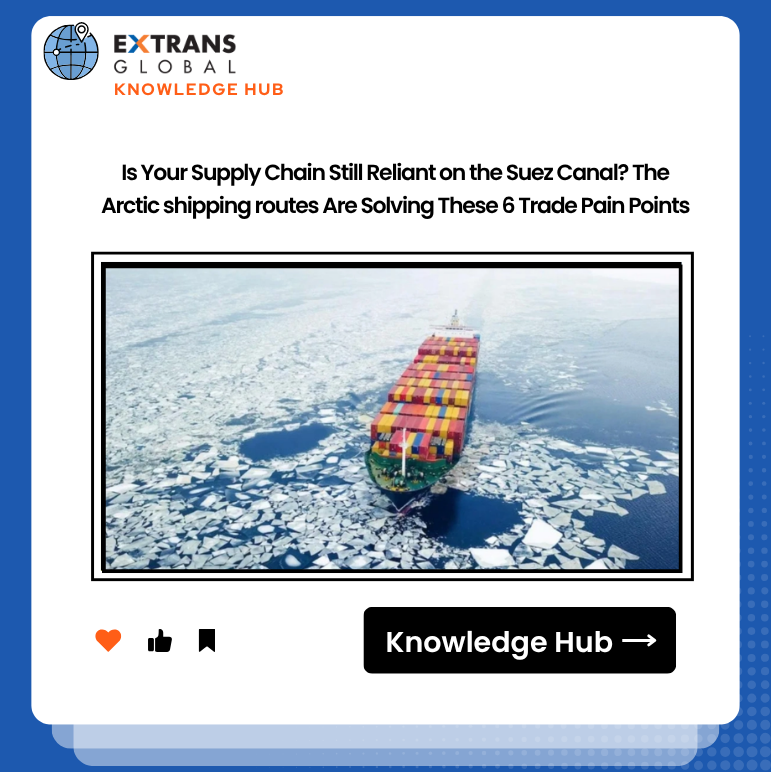Is Your Supply Chain Still Reliant on the Suez Canal? The Arctic shipping routes Are Solving These 6 Trade Pain Points

On the grand chessboard of global trade, the Arctic shipping route is moving from the fringes to the center of the stage. With its unique geopolitical advantages and huge potential, it is quietly rewriting the rules and patterns of international trade. Today, let's delve into the profound impact of the Arctic shipping route on international trade and the infinite possibilities it brings to global business.
1. Voyage & Cost Pain Point: How Does a 40% Shorter Voyage Create a Multi-Million Cost Advantage?
The Arctic shipping routes are reshaping shipping economics with their disruptive distance advantage. Take the Shanghai-Rotterdam route as an example:
- Traditional Suez Route: 13,000 nautical miles, 25-30 days sailing, with single-voyage fuel costs reaching $8 million (Source: Lloyd's Register 2025 Shipping Cost Report).
- Arctic Northeast Route: Voyage reduced to 7,800 nautical miles, sailing time compressed to 15-20 days, single-voyage fuel costs dropping to $2 million. With a $700,000 Suez Canal toll waiver, the comprehensive cost is reduced by $6 million per voyage.
Enterprise Case Study:
In 2025, Volvo used the Arctic shipping routes to transport electric vehicles, cutting the delivery cycle from Sweden to China from 45 days to 22 days. This reduced logistics costs by 25%, allowed a 12% price cut for end products, and gave them a 15% delivery timeliness edge in the new energy vehicle market (Source: Volvo Supply Chain Strategy White Paper).
2. Supply Chain Risk Pain Point: The Resilience Value of the Arctic shipping routes from the Suez Blockade
The 2021 Suez Canal blockade stands as a warning for global supply chains:
- 6 days of congestion stranded over 300 vessels and interrupted $9.6 billion in cargo deliveries (Source: S&P Global Market Intelligence).
- Had the Arctic shipping routes been operational at scale, at least 30% of emergency cargo could have been diverted, avoiding losses like the €200 million production halt for a German automaker due to stranded components.
Leading Enterprise Practice:
Maersk has shifted 15% of its Asia-Europe capacity to the Arctic shipping routes. During the 2024 Red Sea armed attacks, its Arctic shipping routes on-time delivery rate reached 98%, 42 percentage points higher than the 56% of traditional routes (Source: Maersk 2024 Operational Report).
3. Resource Trade Pain Point: The Breakthrough Path for Arctic Energy Transportation
The Arctic holds resources that could rewrite global energy trade:
- US Geological Survey data shows the Arctic contains 13% of the world’s undiscovered oil and 30% of natural gas reserves, with the Yamal LNG project alone producing 16.5 million tons annually.
- Transport via the Arctic shipping routes shortens the voyage by 40% and reduces costs by 35% compared to rounding the Cape of Good Hope, driving China’s LNG imports from this project to 18% of total imports (Source: China Customs 2024 Statistics).
Infrastructure Milestone:
Russia’s new LNG terminal in Murmansk, operational in 2025, achieves "production-to-loading" in 48 hours—three times more efficient than traditional storage and transportation models.
4. Trade Pattern Pain Point: The Geographical Marginalization Dilemma of Emerging Markets
The Arctic shipping routes are reshaping the global trade coordinate system:
- Distance Revolution: Maritime distance from Asia to Northern Europe is shortened by 40% (e.g., sailing time from Bergen, Norway to Shanghai reduced from 42 days to 25 days), and to North America by 25%, forming new trade timeliness zones.
- Hub Migration: Singapore Port saw a 22% surge in Arctic transshipment cargo in 2024, while CMA CGM invested $2 billion in building a new hub in Lagos, Nigeria, expected to handle 3 million TEU of Arctic-diverted cargo by 2027 (Source: CMA CGM Strategic Announcement).
5. Environmental Compliance Pain Point: A 30% Carbon Emission Reduction Solution for ESG
Under the IMO 2025 Carbon Intensity Indicator (CII), the Arctic shipping routes demonstrate significant green advantages:
|
Indicator |
Traditional Route |
Arctic shipping routes |
|
Single-voyage CO₂ |
12,000 tons |
8,400 tons |
|
Carbon Intensity |
0.8t/TEU·nm |
0.56t/TEU·nm |
Source: IMO 2025 Shipping Carbon Emission Report
Technological Innovation Benchmark:
COSCO Shipping’s order of 12 methanol-powered container ships (scheduled for 2026) will achieve "zero-carbon shipping" on the Arctic shipping routes, meeting the EU’s 2026 CBAM maritime carbon tariff requirements. This reduces per-container carbon costs by $80-120, setting a new cost benchmark for green shipping.
6. Infrastructure Weakness Pain Point: The Transition from Ice Wasteland to Hub
Arctic ports are evolving from "polar outposts" to "logistics hubs":
- Russia’s Strategic Layout: The Pevek Port in the Chukchi Sea completed its first phase in 2025, with an annual throughput of 1.2 million TEU and automated container terminals, boosting operational efficiency by 80% compared to traditional ports.
- Chinese Participation Case: CCCC won the bid to expand Reykjavik Port in Iceland, creating the Arctic’s first multimodal hub. Scheduled for 2027, it will handle 30% of Arctic shipping routes transshipments, forming a "Arctic-Europe-Asia" tripartite linkage (Source: CCCC 2025 Infrastructure Announcement).
Conclusion: The 3-Year Window from Emergency Option to Strategic Priority
The Arctic shipping routes have transcended its role as a "cost optimization tool" to become a core component of supply chain strategic infrastructure. Enterprises should complete three strategic deployments within three years:
- Establish an evaluation system for Arctic shipping routes suitability for high-value goods (electronics, automobiles, precision machinery).
- Build warehousing strategic partnerships with Arctic ports like Murmansk and Pevek to seize transshipment nodes.
- Reserve ice-class vessel capacity through long-term charters or capacity pools to lock in the July-September navigation window.
As the Suez Canal’s "monopoly dividend" fades, the Arctic shipping routes is opening a new dimension of international trade competition centered on "distance-cost-greenness". Those who can take the lead in transforming the Arctic shipping routes from an "alternative plan" to a "core capability" will gain strategic initiative in the global supply chain restructuring of the next decade.

top



